One year ago, state media largely ignored the biggest outbreak of civil unrest in Kazakhstan’s history. The job of informing the public objectively about the widespread protests fell on independent reporters and a few so-called citizen journalists and bloggers who did their jobs at great personal risk. These journalists were attacked by protesters, assailed and tear-gassed by police, shot with rubber bullets, detained, and in some cases arrested, beaten, and imprisoned.
When the air, so recently filled with smoke from grenades and bullets, both rubber and real, cleared, reporters were the ones pressing the government for a full accounting of the 238 people killed, more than 4,500 injured, around 10,000 detained, and several hundred reportedly tortured.
This is the story of the Qandy Qantar — “Bloody January” — uprising through the eyes of those who covered it, beginning in Zhanaozen and ending in Almaty.
You can read this series in English at The Diplomat and in Russian and Kazakh at Orda.kz.
TARAZ, Kazakhstan: Nuradin Rakay had not left his house in five days. He’d heard through colleagues that he was on a list of people to be arrested after having attended the city’s January 2022 protests.
Nuradin said he had gone to the city center as an independent journalist on January 4 but hadn’t worn his press vest as he livestreamed the protest to his Facebook page. But then, Nuradin — a former press secretary to the regional mayor and adviser to the city mayor — put down his camera and in an authoritative voice made two speeches, each lasting about a minute.
Afterward, a policeman pulled Nuradin from the crowd and urged him to leave immediately. He did. Minutes later, police dressed in black clothes and surgical masks began grabbing protesters and ushering them into police buses. Two journalists were briefly detained. A third, Aizhan Auelbekova, a correspondent for Vremya, was taken to the police station where she said she was beaten before being released three hours later.
Nuradin was summoned to the police station, too. Police told him there would be an investigation, advised him to return home, and warned him not leave his house. For days Nuradin waited. Through friends he learned how thousands of protesters had amassed on the square and how the peaceful rally had turned into a deadly riot.
On the night of January 6, protesters set fire to the buildings of the regional mayor, a political party building, several police buildings, and a pre-trial detention center.
Security forces returned fire on what they said was an armed group of protesters. The Zhambyl regional mayor said 15 people were killed, all from bullet wounds. (RFE/RL’s Kazakh Service, Radio Azattyq, lists 18 deaths from the region.) More than 288 people were injured, most of them between 17 and 25 years old.
On January 9, Nuradin heard the knock at his front door that he’d been expecting.
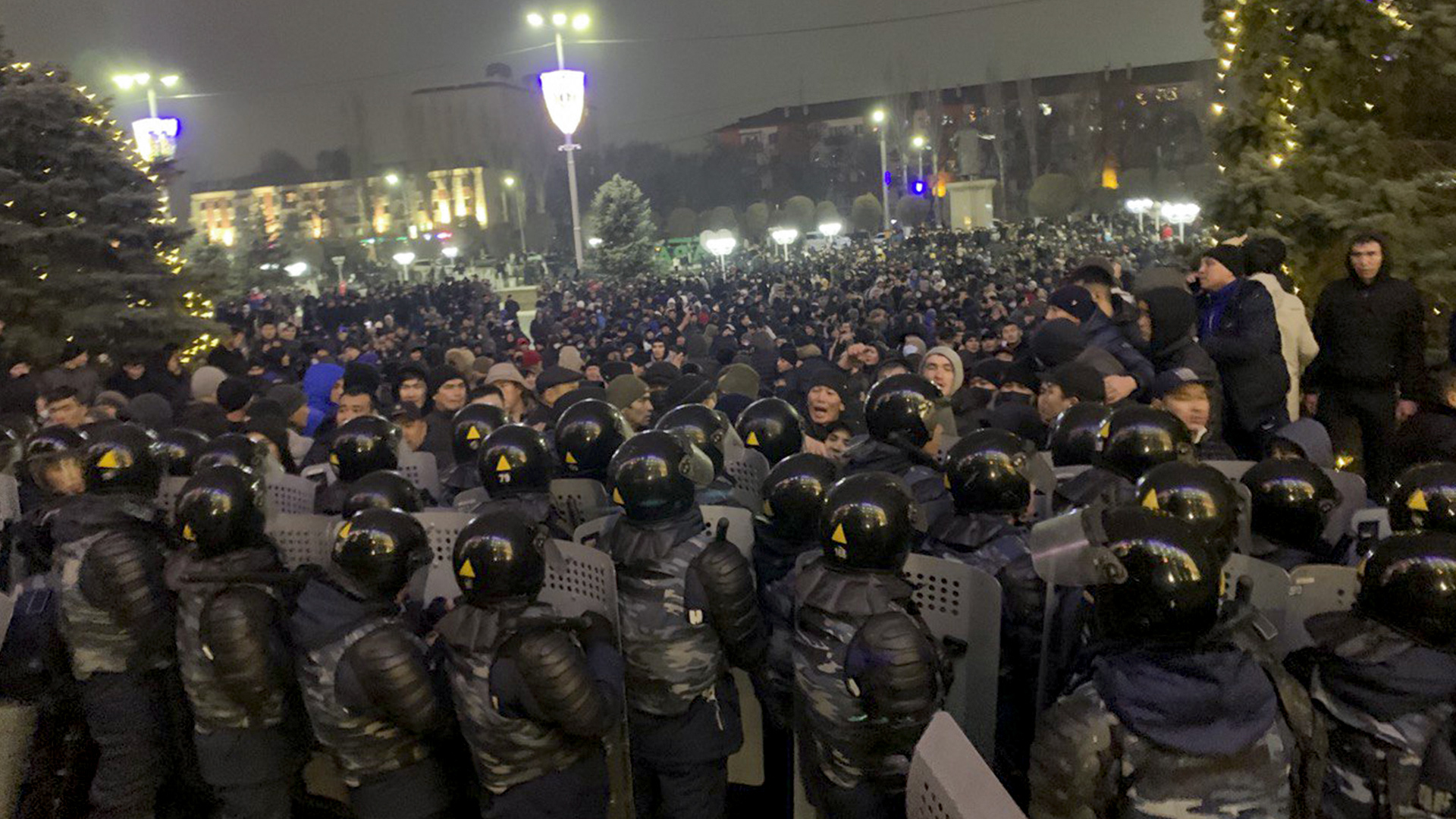
Large crowds gathered in Taraz to protest in early January 2022. Photo credit: Islambek Dastan
Watchers
About 110 miles west of Taraz lies Shymkent, with a population just over 1 million — more than twice that of Taraz. Although the two cities in southern Kazakhstan are dissimilar in many ways, the protests and law enforcement response in both during early January played out in eerily similar ways. Like Taraz, protests in Shymkent started around noon on January 4 but were scattered throughout the city.
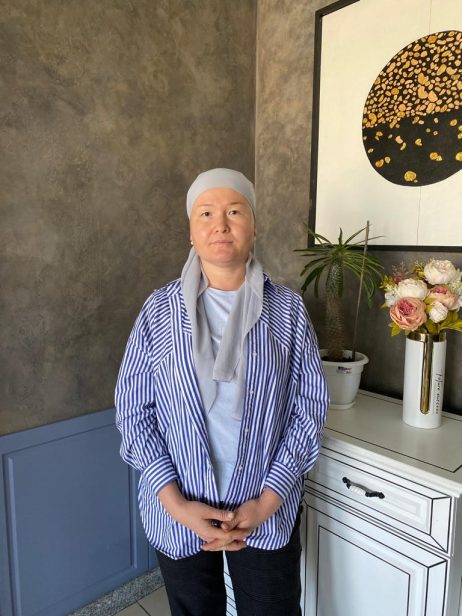
Dilara Isa, 36, was a reporter for Azattyq in early January when protests broke out in Shymkent. Photo provided by author.
On that day, Dilara Isa, 36, then a reporter for Azattyq, noticed several people sitting in a car watching her house. Dilara was used to seeing such watchers. For years, people dressed in civilian clothes would show up outside her house and follow her any time there was a protest. Dilara normally took the bus to protests because she felt safer amid the other passengers. But at least one of the watchers would get on the bus, too, and then brazenly take pictures of her. Several times Dilara confronted the watchers — who she believes are police or state security officers, known as KNB — demanding to know why they were following her and taking her picture. But they never answered.
When Dilara arrived at the square in front of the city hall on January 4, she noticed about 20 protesters and the same people who had been staking out her house. Dilara traveled around the city filming sporadic protests that were quickly quashed when police hauled away some of the protesters. Wherever she went, the watchers followed her.
Wearing a press vest and a mask with the Azattyq logo, Dilara livestreamed the peaceful rallies directly to the Azattyq website. She filmed people holding up the Kazakhstan flag and singing the national anthem. At one point while she was filming police arresting protesters, a female police officer, who Dilara knew, demanded she stop recording. Dilara asked the officer not to disrupt her work, but the officer stood in front of her camera and continually blocked Dilara’s view.
By 8:30 p.m. about 5,000 people had gathered on Al-Farabi Avenue between Shymkent Plaza, which houses a multi-level shopping center and the Russian Drama Theater.
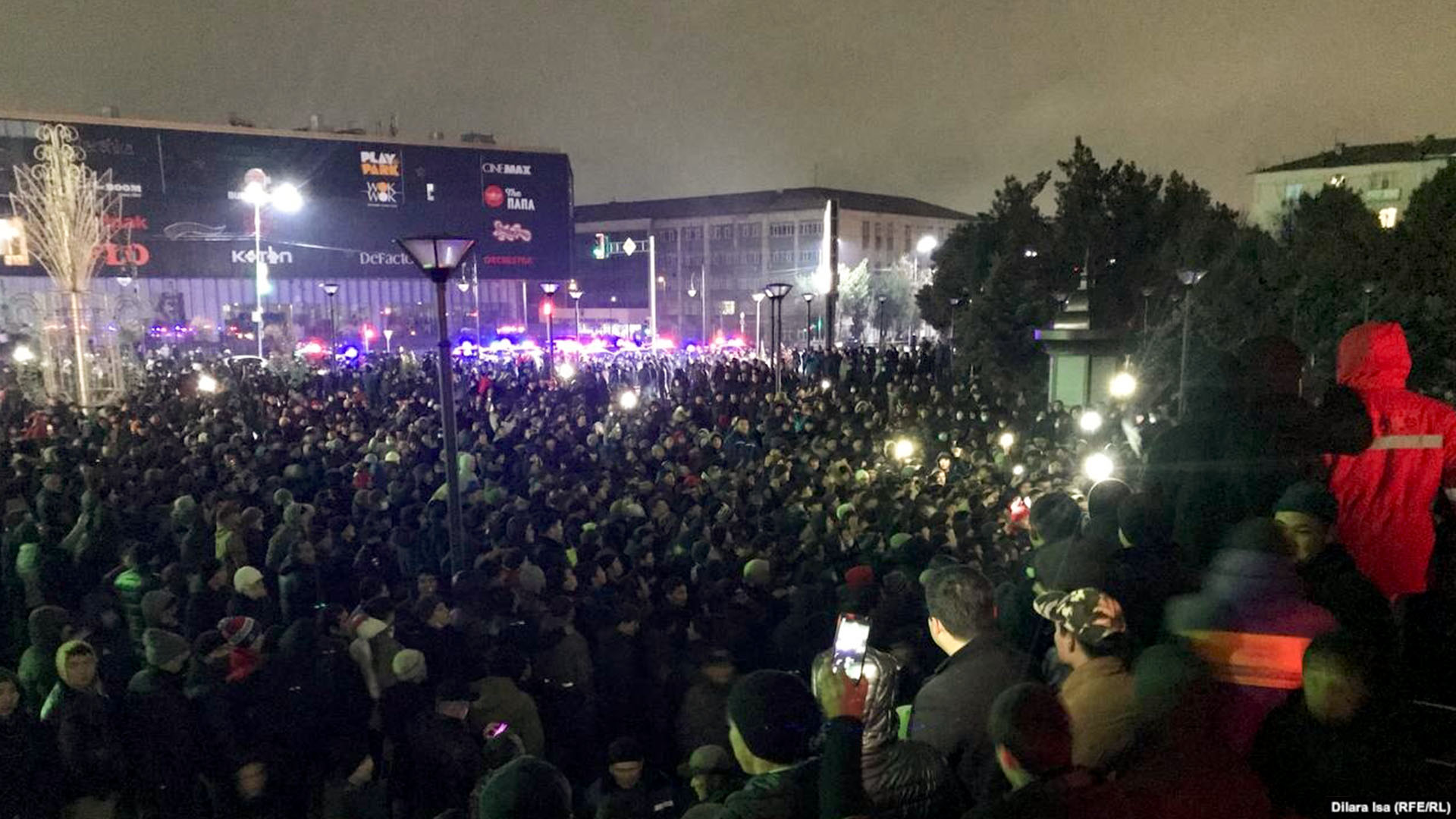
Thousands gathered outside Shymkent Plaza. Photo credit: Dilara Isa for RFE/RL’s Kazakh Service, Azzatyq.
“For a moment, the crowd and the police seemed at a loss as to what to do next,” Dilara said.
Police blocked the streets but stopped trying to detain anyone. Then the internet ceased operating, but Dilara continued to film.
“All I was thinking is that I have to cover everything because I was the only journalist there,” she said. “All of the responsibility to cover this fell on me.”
Protesters made a list of social demands and insisted police release those that had been detained. By 11 p.m. more than 10,000 people crowded into the area near the plaza. The crowd was loud but peaceful. They demanded the city mayor address them; when he didn’t appear, they decided to walk to city hall, about five and half miles away.
As the crowd marched they sang the national anthem and stopped traffic. Those in cars turned on patriotic songs at full volume and rolled down their windows. Some shouted: “Old man go away!” “Wake up Kazakhs!” “Down with corruption!”
The procession stretched for more than a mile. Residents stood on their balconies on both sides of the streets to watch. Protesters encouraged the bystanders to join them.
Most protesters were young, Dilara said. Many were women and activists, but there also was a contingent of men wearing beards and short pants — distinctly Islamic dress — who shouted “Allahu Akbar” — “God is the greatest.” Some protesters advised the crowd not to destroy property.
When the crowd reached city hall at 1:30 a.m. on January 5, they were met by an additional 1,000 protesters already gathered on the city square. Dilara saw people trying to get into city hall.
The peaceful rally then turned ugly: Someone threw stones and broke windows at city hall.
“I couldn’t believe my eyes when I saw someone climb on top of the police car and started kicking it and breaking windows,” Dilara said. When she got closer, she saw that the police car had been turned over.
“One of them said: ‘Let’s destroy all the cars.’ In 10 minutes, the windows of dozens of police cars were smashed,” she said. “There was smoke and dust mixed in the air.”

A police vehicle overturned amid the early January 2022 protests in Shymkent. Photo credit: Dilara Isa for RFE/RL’s Kazakh Service, Azzatyq.
“People Were Crying and Suffering”
On January 9, three days after the protests ended in Taraz, Nuradin opened his front door to find police dressed in civilian clothes.
“They took me to the station and arrested me,” Nuradin said. “I was beaten. They beat me with their hands, with a gun, with a baton. I was mainly beaten on my body, on my kidneys. But it wasn’t only me. We were in a small barracks, and they were bringing more and more people —more than a hundred people. There was no air in there. People were crying and suffering.”
Nuradin said he was forced to pass through a small corridor where police were beating 10 people at a time.
“I thought that I was going to die,” he said. He wondered what would come next and whether he could sustain the blows.
Hearing the cries of others being beaten brought him back to the moment and the question of why he was punished for speaking up. He reflected on what he’d said on the square. He thought he was doing the right thing, advising the protesters to not destroy property and to make their demands known to the mayor.
Police, wearing masks and civilian clothes, forced him and others to lie in a prone position while the beating resumed. The first day he fell unconscious after he was beaten. He had a hard time breathing. Then his kidneys stopped working and for three days he couldn’t urinate.
As the beatings continued, Nuradin fell in and out of consciousness. He was afraid at some point he simply wouldn’t wake up. “I thought if I die, I will not be able to prove that I am not guilty,” he said.
Police dragged him into a special room for interrogation and used psychological tricks on him. “They would tell me: ‘Yesterday we saw you with a grenade in your hands; we saw you with a gun.’ ”
During the interrogation he wasn’t allowed to look at his interrogators. During beatings he said he was made to face the wall or away from the person administering the punishment. “They force you to say that you saw some person, you knew some person. If you refused to say what they told you, they made you enter the room where the beatings took place.”
Nuradin continued to insist he was innocent. He’d been at home since January 4, adhering to the police warning not to return to the city square.
“I was quite a famous journalist around here, and I also had some official position in the mayor’s office as an adviser,” he explained.
He said his interrogators knew this and taunted him. “They said: ‘Well, why don’t you write about this then?’”
After learning that he had been detained, many friends were afraid to go his house, he said. The community treated his family as if he had become “an enemy of the nation.”
“My wife and children did not know if I was alive or dead,” he said.
Protesters Become Aggressive
As the protest in the early morning hours of January 5 grew violent, the protesters became more aggressive toward Dilara, too. One man scolded Dilara for filming the violence, saying her photos and videos would get protesters in trouble. She ignored him. Others grabbed at her arm, trying to yank away her phone. A young man with a beard and short trousers yelled at her to stop filming. She told him not to interfere. A teenager with the man said they would tell the “abi” and he would break her phone. An “abi” is the leader of a religious group.
Dilara noticed that the protesters who smashed windows and damaged cars were different from the peaceful protesters who’d put forward demands, sang the national anthem, and advised others in the crowd not to destroy property.
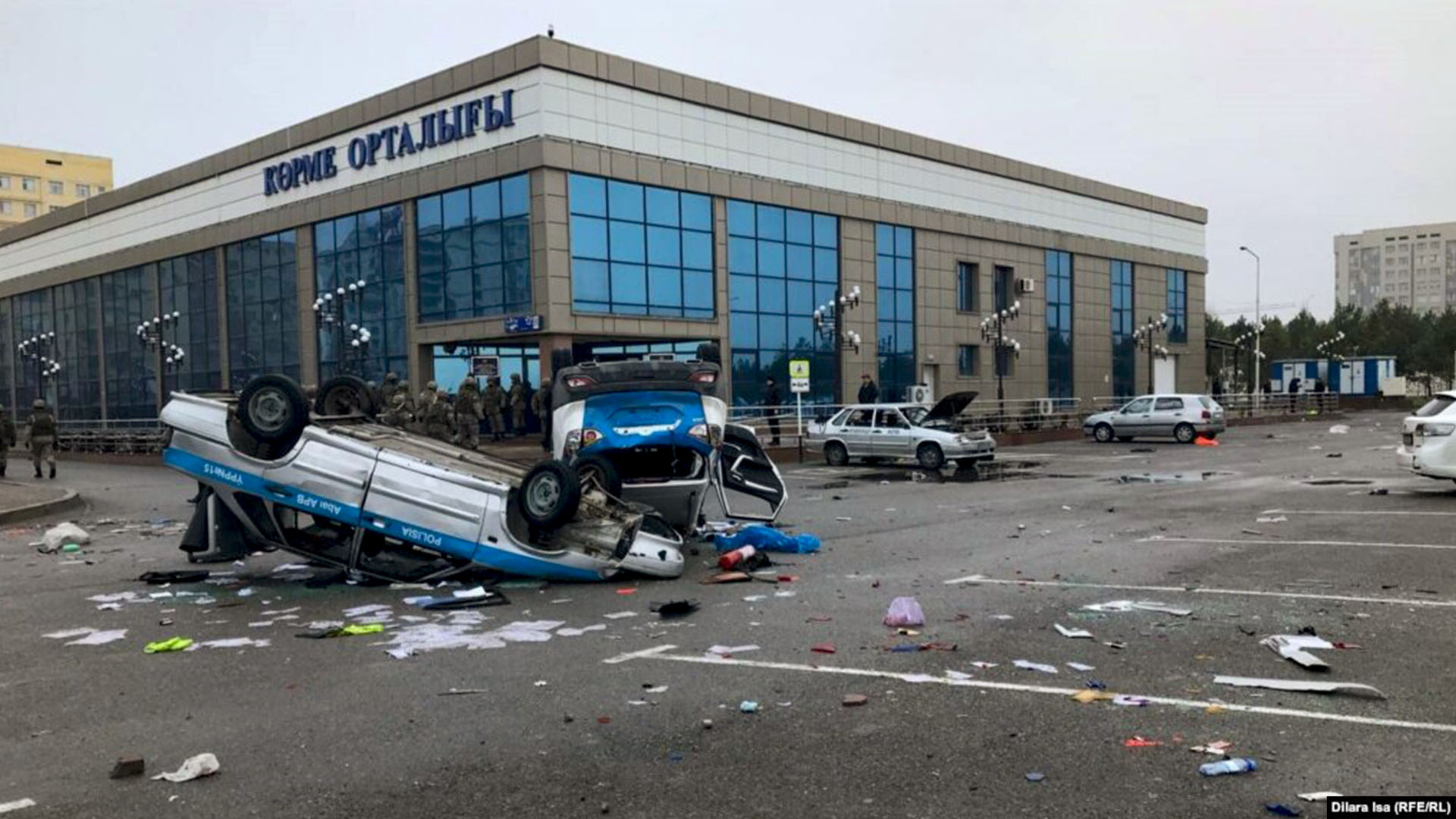
More police vehicles lay overturned after protests became violent in Shymkent. Photo credit: Dilara Isa for RFE/RL’s Kazakh Service, Azzatyq.
As protesters grew more aggressive toward her, Dilara decided she needed to leave. Her husband had joined her once she’d reached city hall, but by then she felt it was too dangerous for the two of them. Her husband drove them home around 3 a.m., followed by the car full of watchers.
From home, Dilara and her husband could still hear the sound of exploding stun grenades coming from the vicinity of city hall, a 15-minute drive from their house.
Witnesses called her on the phone and said security forces were using a water cannon.
The morning of January 5, Dilara went to city hall and saw police and soldiers lined up in front of the building. Nearby were a dozen destroyed and overturned police cars.
“The city seemed to be gripped by an incomprehensible fear,” she said. Everywhere she went, people were whispering that another protest was planned for that evening at city hall. “People were warned to take cash from the banks. Some banks had stopped working. They were warned to get groceries before 5 p.m. because the shops were closing. There was a lot of panic.”
Dilara planned to cover the protest a second night, but when she called her editor at the Azattyq office in Almaty, she was told that journalists in Almaty had been shot at. Editors were ordering reporters to stay home.
From home at about 9 p.m., Dilara said she again heard the sound of stun grenades coming from city hall. Two hours later, several activists she knew called her and said people had been shot, some fatally, and many were injured. Why wasn’t she there? They asked. She told each of them that she’d been ordered to stay away by her editors.
Dilara said she fought the urge to return to the scene all night.
The calls kept coming until 3 a.m. She reminded herself she was the married mother of four children.
“I couldn’t close my eyes,” she said.
The shooting continued until 6 a.m., she said.
Later that morning, Dilara went to city hall and found 50 to 60 protesters milling about. Soldiers encircled the mayor’s burned-out office building. There was blood on the ground and bullet casings. Cobblestone on the square was destroyed. Cars were burned.
Several activists told her how members of the military and special forces had begun shooting and how ambulances couldn’t reach injured people.
“I regretted then that I did not come out at night and record what was happening,” she said.
Like a Russian Crime Movie
On his fourth day in detention, January 12, Nuradin turned 35. He didn’t know how long he was going to have to stay in that place.
At some point, Nuradin said he had a trial before a judge who appeared on a video monitor. “The judge told me that there should just be a warning and I should have to pay a fine.”
“I told them that I am not going to pay money and that if I have any guilt, I will go to prison. I am not in any condition to pay any money. I have five children to raise.”
Some detainees were fined about 60,000 tenge, about $124, and were happy to pay to be freed from police detention, he said. Others received 10 days of administrative detention and didn’t dispute the sentencing because it meant they could leave the barracks where they were beaten every day.
On January 21, Nuradin was released. He posted about his 13 days in police detention on Facebook.
“For half a month they investigated whether I was a terrorist,” he wrote. “It was a scene from a regular Russian crime movie. What did the leader of the party whose building burnt down gain from frightening journalists? I am not a terrorist.”
Nuradin’s body was purple with bruises and his head was swollen from being hit, he said. After his release, he was still having difficulty urinating and sought medical treatment. He said doctors at the hospital told him his kidneys were slightly damaged, but it wasn’t critical.
Finding a job was his biggest challenge. After his detention, he said companies were afraid to hire him. “They were thinking that I would bring problems.”
It took five months, but he finally was hired as a journalist at Channel 31, he said. He had previously worked for the channel for nine years until 2019. After that he worked as a press secretary for the regional mayor. And after that job, he worked as an advisor in the Department of State Architectural and Construction Control.
Nuradin contends that before he made his speech on January 4, he resigned from his city position “so nobody would have problems because of me.” But on his Facebook page, Nuradin twice told his readers that he was fired from his job.
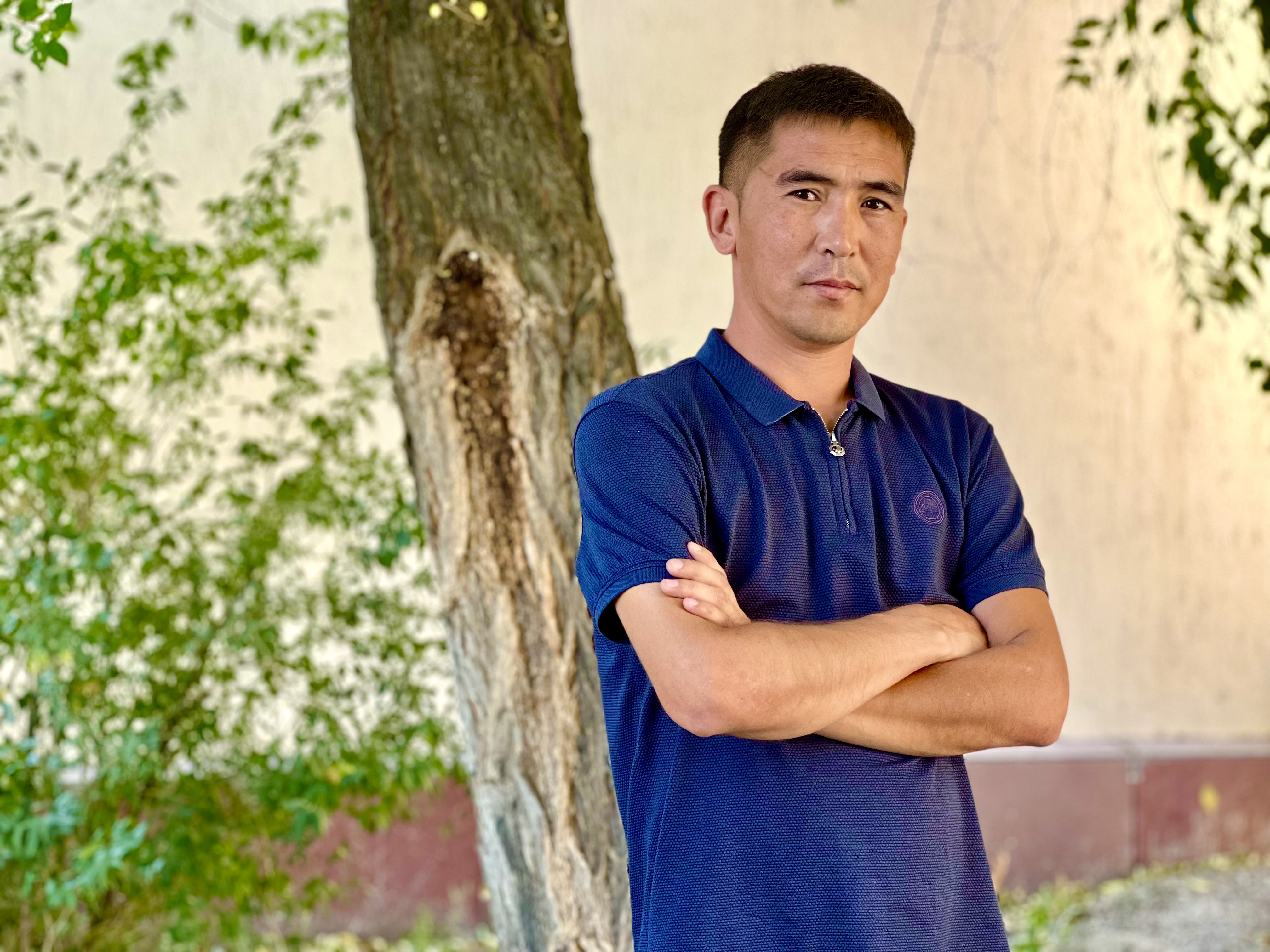
Nuradin Rakay went to the city center of Taraz as an independent journalist on January 4. Photo provided by author.
A Secret Document
Dilara was determined to find out what had happened late January 5 and early January 6 when the shooting started in Shymkent. She interviewed witnesses, the injured, and families of the dead.
Dilara wanted to know how 73 people had been shot and 20 killed, and why police had detained more than 3,500 people. She wrote stories about the dead and covered their cases in court as prosecutors labeled them “terrorists.”
“All these stories started to affect me psychologically,” she said. “The deeper I got in the stories, the details of how some of them died, and how others were purely accidental had an effect on me.”
Dilara believed her phone was tapped and that she remained under surveillance by the KNB or police, so she was careful about where and how she interviewed people. A source, whose identity she continues to protect, provided her a secret police investigative document about the 20 people killed during the protests.
“It was a very important document,” she said. “My editors were shocked.”
For weeks, city officials denied that police and military had used live ammunition against protesters. The secret document Dilara acquired provided undeniable proof that city officials had sanctioned police and special forces to use deadly force on protesters.
According to the document, about 11 p.m. on January 5, Shymkent city officials authorized the police and military officers to fire 9 mm caliber pistols and 12 mm automatic weapons on protesters.
“The protesters were in a state of alcoholic intoxication, were not afraid of stun grenades, tear gas, and water cannons, were highly aggressive and used smoothbore guns and other weapons, threw Molotov cocktails, and attacked the police and the military from all side,” the document stated.
Twenty-three military, 51 police officers and two medical workers were injured, according to the document; 142 police and military cars were burned or damaged. The document also listed items stolen during the protests: two Makarov pistols, 151 pieces of body armor, 81 shields, 57 helmets, 110 rubber batons, 51 radios.
Of the 20 people killed, only three had traces of alcohol in their system, according to the document. Only one of those killed was found with a weapon: an automatic pistol and four rounds of ammunition.
The families of the dead were outraged when they learned the city government had authorized the use of live ammunition. “My son went to a rally,” said Murat Abdraimov, father of Nurbolat Alpamys, 19. “But he didn’t break anything. My son was shot in the head. Why are they allowed to shoot at ordinary peaceful people?”
In November, President Kassym-Jomart Tokayev granted amnesty to hundreds of people who were charged and imprisoned in connection with the January protests. Human rights activists say the amnesty allows law enforcement officers who opened fire on unarmed demonstrators to evade prosecution.
***
Tomorrow, January 7, we will follow the story of Kazakhstan’s Bloody January to Almaty.
Kazakhstan’s Bloody January: Day 5, Taraz to Shymkent
Source: Frappler

0 Comments